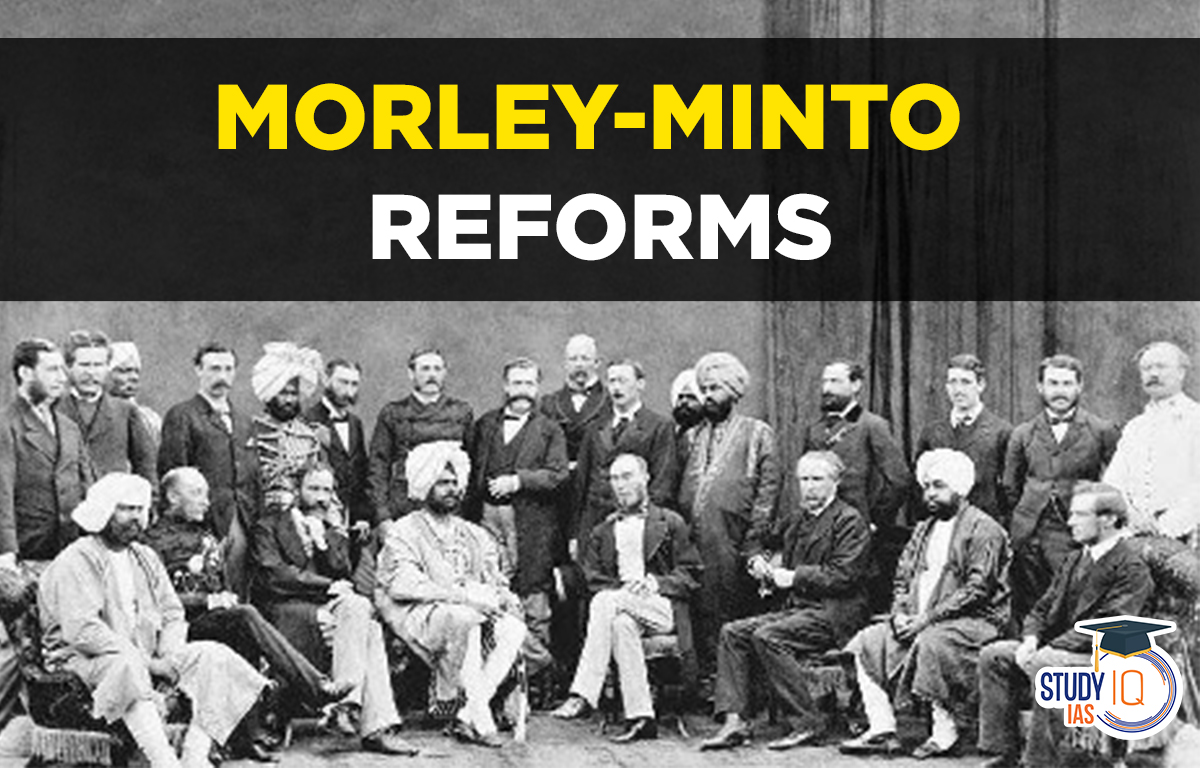Table of Contents
Morley-Minto Reforms
The British Parliament passed the Morley-Minto Reforms in order to increase the representation of Indians in the administration of British India. In addition to updating the Indian Councils Acts of 1861 and 1892, the Indian Councils Act of 1909 also introduced the idea of a separate electorate.
The Morley-Minto Reforms, sometimes referred to as the Indian Councils Act (1909), was created by John Morley, the secretary of state for India from 1905 to 1910. Indian Councils Act (1909), a significant component of the UPSC/IAS Exam Polity and Governance syllabus, is covered in-depth in this article.
Morley-Minto Reforms 1909 Background
The Indian Councils Act of 1892 did not achieve the realistic goals of the Congress party, which is primarily why this act was passed. In 1905, Lord Curzon also carried out the division of Bengal. As a result, Bengal experienced a significant uprising. Following this, the British emperors concluded that the Indian administration needed to be improved in order to address the issue.
Additionally, the Indian National Congress (INC) pushed for more reforms and Indian self-government. Congress leaders had previously been moderate, but as time went on, the number of radical leaders who supported more aggressive tactics began to rise. The INC made its first claim for home rule in 1906. Gopal Krishna Gokhale met with Morley in England to emphasize the significance of changes.
When the Simla Deputation met Lord Minto in 1906, they proposed a distinct Muslim electorate headed by the Aga Khan. John Morley was a Liberal government official in India who sought to enhance the nation’s administration. To win over Muslims and moderate members of the Indian National Congress, the Indian Councils Act of 1909 was passed.
| Indian National Movement From 1905-1918 | |
| Indian National Movement |
First World War |
| Partition of Bengal | Swadeshi Movement |
| Muslim League | Morley-Minto Reforms 1909 (Indian Council Act 1909) |
| Ghadar Movement | Komagata Maru Incident |
| Lucknow Pact | Home Rule Movement |
| Surat Split |
|
Morley-Minto Reforms Objective
The objective was to improve Indian participation in the administration of British India by applying the electoral principle to membership in the imperial and local legislative councils of India.
Read More: Pitt’s India Act 1784
Morley-Minto Reforms Provisions
Legislative councils have grown in size on both the federal and provincial levels. Individuals on the Central Legislative Council range in age from 16 to 60. The Legislative Councils of Bengal, Madras, Bombay, and the United Provinces each have 50 members. There are 30 members in each Legislative Council of Punjab, Burma, and Assam.
The members who were chosen were chosen in an indirect manner. Local governments chose the members of the provincial legislative councils through an electoral college. These people would choose the Central Legislative Council’s members. Local governments, business chambers, landlords, educational institutions, trade associations, and Muslims were among the electors.
Members of the provincial council tended to be unofficial. A non-elected majority did, however, exist overall as a result of the nomination of numerous unofficial members. Indians were granted their first official welcome by the Imperial Legislative Council. Muslim electorates existed separately. Only Muslims were permitted to vote in some races, and only Muslims could choose their MPs.
It accepted the idea of a “separate electorate,” introducing a system of communal representation for Muslims. According to this, only Muslim voters could elect Muslim members. The Act effectively “legalised” communalism, and Lord Minto became recognized as the Father of the Communal Electorate as a result.
Resolutions could be put forth and the budget discussed. They could also talk about issues that are significant to the general populace. They could also ask more questions to learn more. Discussions of foreign policy or connections with princely states were off-limits. The first Indian representative, Satyendra P Sinha, was appointed to the Viceroy’s Executive Council (after great pressure from Morley). Two Indians have been added to the Council on Indian Affairs of the Secretary of State.
Morley-Minto Reforms Significance
It was a move in the right direction toward the responsible integration of elected Indians with the government. For the first time, the members had a chance to express their criticism of the executives and proposals for improving the nation’s administration.
Read More: Partition of Bengal
Morley-Minto Reforms Defects
Separate seats were established in order to widen the gap between Muslims and Hindus. This regime ushered in an openly communist period in Indian politics. Although the councils’ numbers increased, neither their duties nor their authority did. Despite the fact that the Provincial Councils had a non-official majority, the outcome was unimportant because the election of nominated members negated the non-official majority.
The Act had no bearing on the General Governor’s office or veto power. The budget was open for discussion, but no substantial adjustments could be made by the members. The CEOs could be questioned about the resolutions, which were more like suggestions to the government, but they could not be forced to do so. The Morley-Minto Reform obscured the political and economic problems that both Hindus and Muslims experienced in India.
Read More: Freedom Fighters of India


 Jallianwala Bagh Massacre, Date, History...
Jallianwala Bagh Massacre, Date, History...
 Important Lakes of India, State wise and...
Important Lakes of India, State wise and...
 Buddhism History, Origin, Sect, Councils...
Buddhism History, Origin, Sect, Councils...





















